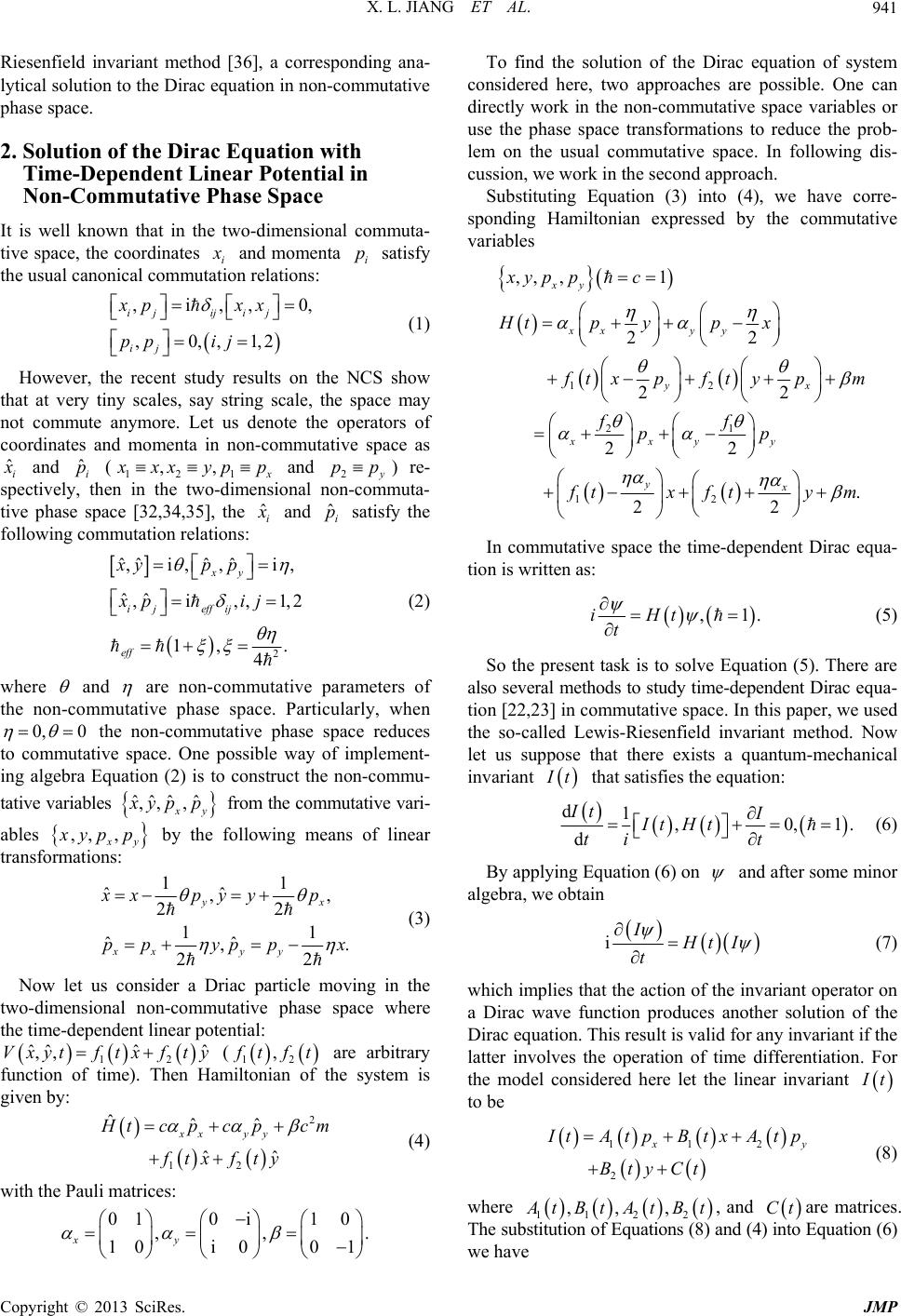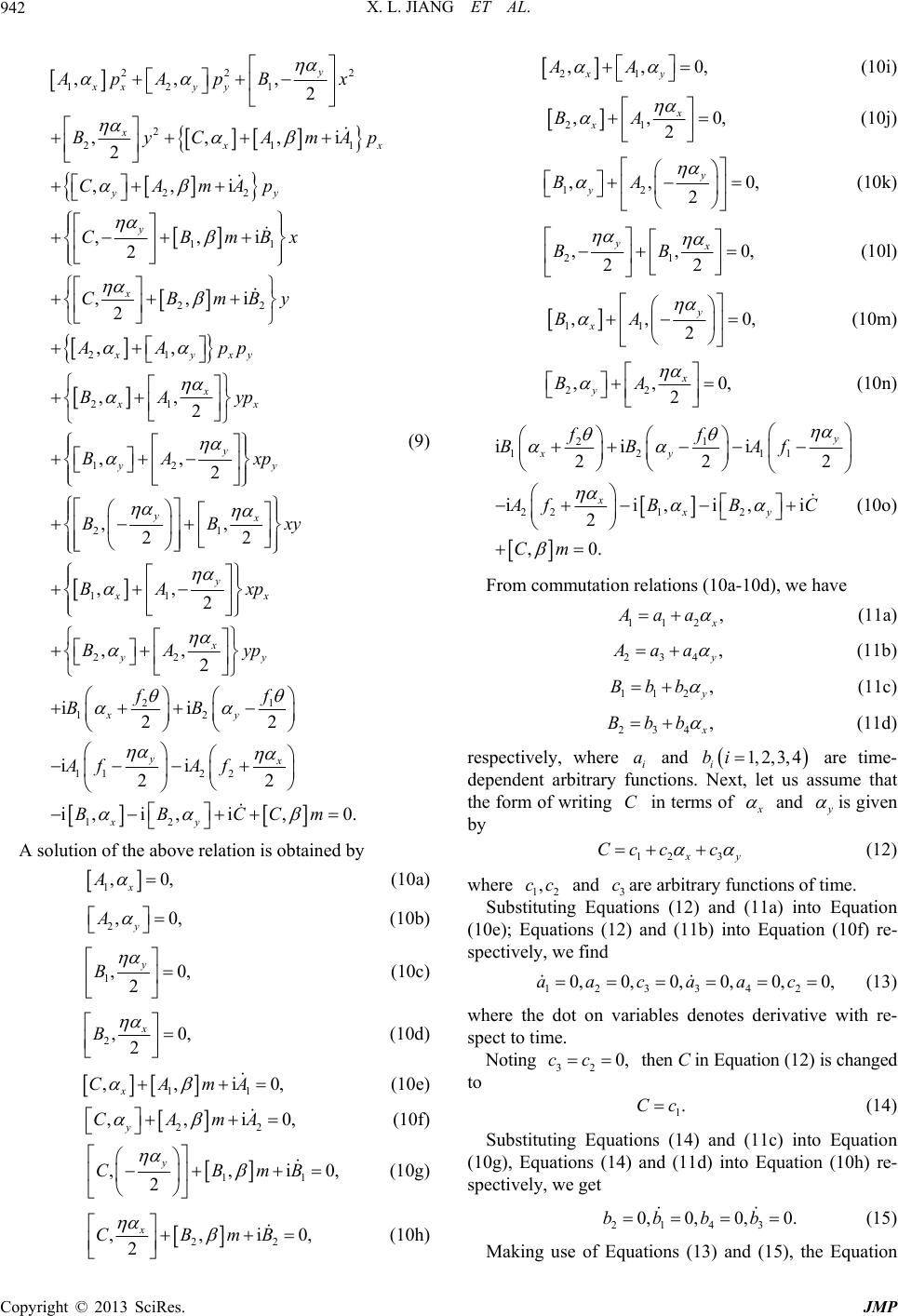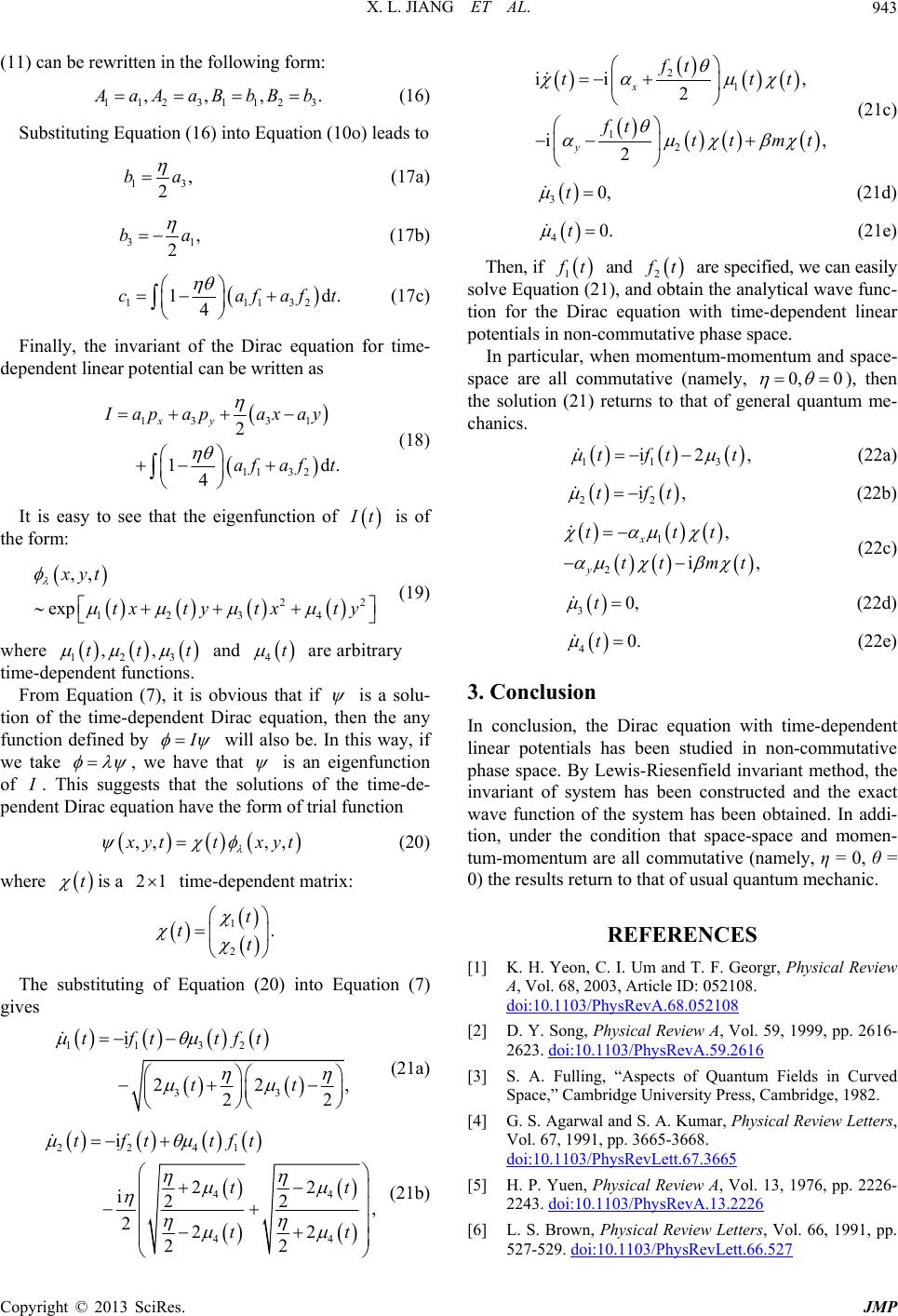 Journal of Modern Physics, 2013, 4, 940-944 http://dx.doi.org/10.4236/jmp.2013.47126 Published Online July 2013 (http://www.scirp.org/journal/jmp) Solution of Dirac Equation with the Time-Dependent Linear Potential in Non-Commutative Phase Space* Xueling Jiang1, Chaoyun Long2#, Shuijie Qin2 1School of Mechanical Engineering, Guizhou University, Guiyang, China 2Laboratory for Photoelectric Technology and Application, Guizhou University, Guiyang, China Email: #long.chaoyun@163.com Received April 13, 2013; revised May 16, 2013; accepted June 15, 2013 Copyright © 2013 Xueling Jiang et al. This is an open access article distributed under the Creative Commons Attribution License, which permits unrestricted use, distribution, and reproduction in any medium, provided the original work is properly cited. ABSTRACT In this paper, the time-dependent invariant of the Dirac equation with time-dependent linear potential has been con- structed in non-commutative phase space. The corresponding analytical solution of the Dirac equation is presented by Lewis-Riesenfield invariant method. Keywords: Non-Commutative; Dirac Equation; Time-Dependent Linear Potentials; Exact Wave Function 1. Introduction It is well known that the quadratic Hamiltonian system includes not only conservation system but also time-de- pendent system [1,2]. The study of time-dependent quantum-mechanical system has attracted considerable interest over the past decades because their quantum correspondence provides fundamental structure of basic physics and interpretation of new physics in different areas of physics, such as, gravitation [3], quantum optic [4,5], the Paul trap [6-8] and spintronics [9]. In the past few decades, an extensive effort has been made to obtain exact solution of the Schrödinger equation with time- dependent harmonic o scillator [1 0-14] making us e of dif- ferent methods, for example path integral, second quan- tization and dynamical invariant. Besides the time-de- pendent harmonic oscillator, the time-dependent linear potential model has also been employed to study several problems in physics. For instance, Cocke and Reichl have employed this model to study the effects of static field on the stochastic layer of microwave-driven hydro- gen [15] and on nonlinear quantum resonances and the ionization spectrum of a simple bound particle [16] and compute the spectrum of emitted radiation for a particle in a triangular potential well and driven by an electro- magnetic field [17]. Recently, Schrödinger equation [18- 21] and Dirac equation [22-24] of linear potential model have also been investigated widely and the corresponding exact solutions have been given, in one dimension. In spite of a large variety of papers that has been pub- lished concerning time-dependent Schrödinger equation and Dirac equation in commutative space, no one has reported the study of the time-dependent quantum prob- lems in non-commutative space. While, there has been much interest in the study of ph ysics in non-commutative spaces (NCS) in recent year [25,26], not only because the NCS is necessary when one studies the low energy effec- tive of the D-brane with B field background, but also because in the very tiny string scale or at very high en- ergy situation, the effects of non-commutativity of space may appear. Generally, the theory and methods of re- searching non-commutative problems are mainly from quantum field theory. But, it is fascinating to speculate whether there might be some low-energy effects of the fundamental quantum field theory. These effects might arise as a non-commutative version of quantum mechan- ics [27-29]. Under the frame of quantum mechanics, the Quantum Hall effect [30], Aharonov-Casher effect [31], gravitational quantum well [32] and the two-dimensional anharmonic oscillator [33], have been studied extensively in non-commutative space. In this paper we are interested in non-perturbation in- vestigation of Dirac equation with time-dependent linear potential in non-commutative phase space [32,34,35]. The main purpose of the paper is to construct the time- dependent invariant of the Dirac equation with time-de- pendent lin ear potential and to obtain , throug h the Lewis- *This work was supported by the Foundation of Guizhou province master, China (Grant Nos.(2012)61) and Foundation of social devel- opment of Guizhou province, China ( G rant Nos.(2012)3073). #Corresponding author. C opyright © 2013 SciRes. JMP  X. L. JIANG ET AL. 941 Riesenfield invariant method [36], a corresponding ana- lytical solution to th e Dirac equation in non-co mmutative phase space. 2. Solution of the Dirac Equation with Time-Dependent Linear Potential in Non-Commutative Phase Space It is well known that in the two-dimensional commuta- tive space, the coordinates i and momenta satisfy the usual canonical commutation relations: i p ,,0, ,,1,2 ij ij xx ij ,i ,0 ij ij xp pp (1) However, the recent study results on the NCS show that at very tiny scales, say string scale, the space may not commute anymore. Let us denote the operators of coordinates and momenta in non-commutative space as ˆi and (12 1 ˆi p,, xx yp p and 2 pp ) re- spectively, then in the two-dimensional non-commuta- tive phase space [32,34,35], the ˆi and satisfy the following commutation relations: ˆi p 2 ˆ , i, ,,1,2 1, . 4 xy effij p p ij ˆˆˆ ,i, ˆˆ ,i ij eff xy xp (2) where and are non-commutative parameters of the non-commutative phase space. Particularly, when 0, 0 the non-commutative phase space reduces to commutative space. One possible way of implement- ing algebra Equation (2) is to construct the non-commu- tative var iables ˆˆˆˆ ,, , y yp p ,, , from the commutative vari- ables y yp p by the following means of linear transformations: 11 ,, 2 11 ,. 22 yx yy y p p x ˆˆ 2 ˆˆ xx xx py pp yp , (3) Now let us consider a Driac particle moving in the two-dimensional non-commutative phase space where the time-dependent linear potential: ˆˆ ,,Vxyt f 12 ˆ ˆ txf ty (12 tft 2 12 ˆˆ ˆˆ yy are arbitrary function of time). Then Hamiltonian of the system is given by: ˆxx tcp ftx cp cm f ty 1 0. 0 1 (4) with the Pauli matrices: 010 i ,, 10i 0 xy To find the solution of the Dirac equation of system considered here, two approaches are possible. One can directly work in the non-commutative space variables or use the phase space transformations to reduce the prob- lem on the usual commutative space. In following dis- cussion, we work in the second approach. Substituting Equation (3) into (4), we have corre- sponding Hamiltonian expressed by the commutative variables 12 21 12 ,, ,1 22 22 22 . 22 xy xx yy yx xxyy yx xyp pc Htpyp x tx pftypm ff pp txftym In commutative space the time-dependent Dirac equa- tion is written as: ,1.iHt t (5) So the present task is to solve Equation (5). There are also several methods to study time-dependent Dirac equ a- tion [22,23] in commutative space. In this paper, we used the so-called Lewis-Riesenfield invariant method. Now let us suppose that there exists a quantum-mechanical invariant t that satisfies the equation: d1,0,1. d It I It Ht ti t (6) By applying Equation (6) on and after some minor algebra, we obtain iI tI t (7) which implies that the action of the invariant operator on a Dirac wave function produces another solution of the Dirac equation. This result is valid for any invariant if the latter involves the operation of time differentiation. For the model considered here let the linear invariant t to be 112 2 y tAtpBtxAtp BtyCt (8) ,,, 112 2 where tBtAtBt Ct , and are matrices. The substitution of Equations (8) and (4) into Equation (6) we have Copyright © 2013 SciRes. JMP  X. L. JIANG ET AL. 942 22 12 2 21 22 11 22 21 21 ,, ,, 2 ,,i ,, 2 ,,i 2 ,, ,, 2 xx y y x 2 1 1 , 2 ,i i y x x AmAp p Bx By yy y x xy xy x x ApApB ByC CAmA CBm CBm AApp BA 12 21 11 22 21 12 ,, 2 ,, 22 ,, 2 ,, 2 ii 22 i x y yy yx y xx x yy xy yp BA BB BA x BAy ff BB 21 ,,0, xy AA xp xy p p 112 2 12 i 22 i,i ,i yx xy Af Af BBC , 0.Cm (9) A solution of the above relation is obtained by 1,0, x A 2,0, y A (10a) (10b) 1,0, 2 y B (10c) 2,0, 2x B (10d) 11 i0,mA ,, x CA (10e) 22 i0,mA ,,CA y (10f) 11 ,i0,mB , 2 y CB (10g) 22 i0,mB ,, 2x CB (10h) (10i) 21 ,,0, 2x x BA (10j) 12 ,, 0, 2 y y BA (10k) 21 ,,0, 22 yx BB (10l) 11 ,, 0, 2 y x BA (10m) 22 ,,0, 2x y BA (10n) 21 1211 221 2 iii 222 ii,i,i 2 ,0. y xy x xy ff BBAf AfBBC Cm 112 , (10o) From commutation rela t i ons (10a-10d), we h a ve Aaa (11a) 234 , Aaa (11b) 112 , Bbb (11c) 234 , Bbb a 1, 2, 3, 4bi C (11d) respectively, where i and i are time- dependent arbitrary functions. Next, let us assume that the form of writing in terms of and is given by 12 3 y Cc cc ,ccc 123342 0,0,0,0,0,0,aacaac (12) where and are arbitrary functions of time. 12 3 Substituting Equations (12) and (11a) into Equation (10e); Equations (12) and (11b) into Equation (10f) re- spectively, we find 32 0,cc (13) where the dot on variables denotes derivative with re- spect to time. Noting 1.Cc then C in Equation (12) is changed to (14) Substituting Equations (14) and (11c) into Equation (10g), Equations (14) and (11d) into Equation (10h) re- spectively, we get 2143 0, 0,0,0.bbbb (15) Making use of Equations (13) and (15), the Equation Copyright © 2013 SciRes. JMP  X. L. JIANG ET AL. 943 (11) can be rewritten in the following form: 1123 ,, 1123 ,. aA aB bB b (16) Substituting Equation (16) into Equation (10o) leads to 13 , 2 ba (17a) 31 , 2 ba (17b) 1132 d.afaft 1 1 4 c (17c) Finally, the invariant of the Dirac equation for time- dependent linear potential can be written as 31 11 32 1d . 13 2 4 xy ap ap ax ay af aft (18) It is easy to see that the eigenfunction of t 22 4 ty 4t is of the form: 123 ,, exp xyt tx ty tx ,,ttt (19) where 12 3 and are arbitrary time-dependent functions. From Equation (7), it is obvious that if is a solu- tion of the time-dependent Dirac equation, then the any function defined by will also be. In this way, if we take , we have that is an eigenfunction of . This suggests that the solutions of the time-de- pendent Dirac equation have the form of trial function ,, ,, yt tx yt (20) where t 21is a time-dependent matrix: 1 2 . t tt The substituting of Equation (20) into Equation (7) gives 113 i 22 tft t 2 33 , 22 ft tt (21a) 2241 4 44 i 2 2 , 22 tft tft tt tt 4 2 i2 222 (21b) 21 12 ii , 2 i, 2 x y ft ttt ft tt mt (21c) 30,t (21d) 40.t (21e) 2 1 t and Then, if t 0, 0 are specified, we can easily solve Equation (2 1), and obtain the analytical wav e func- tion for the Dirac equation with time-dependent linear potentials in non-commutative phase space. In particular, when momentum-momentum and space- space are all commutative (namely, ), then the solution (21) returns to that of general quantum me- chanics. 113 i2,tft t (22a) 22 i,tft (22b) 1 2 , i, x y ttt tt mt (22c) 30,t (22d) 40.t (22e) 3. Conclusion In conclusion, the Dirac equation with time-dependent linear potentials has been studied in non-commutative phase space. By Lewis-Riesenfield invariant method, the invariant of system has been constructed and the exact wave function of the system has been obtained. In addi- tion, under the condition that space-space and momen- tum-momentum are all commutative (namely, η = 0, θ = 0) the results return to that of usual quantum mechanic. REFERENCES [1] K. H. Yeon, C. I. Um and T. F. Georgr, Physical Review A, Vol. 68, 2003, Article ID: 052108. doi:10.1103/PhysRevA.68.052108 [2] D. Y. Song, Physical Review A, Vol. 59, 1999, pp. 2616- 2623. doi:10.1103/PhysRevA.59.2616 [3] S. A. Fulling, “Aspects of Quantum Fields in Curved Space,” Cambridge University Press, Cambridge, 1982. [4] G. S. Agarwal and S. A. Kumar, Physical Review Letters, Vol. 67, 1991, pp. 3665-3668. doi:10.1103/PhysRevLett.67.3665 [5] H. P. Yuen, Physical Review A, Vol. 13, 1976, pp. 2226- 2243. doi:10.1103/PhysRevA.13.2226 [6] L. S. Brown, Physical Review Letters, Vol. 66, 1991, pp. 527-529. doi:10.1103/PhysRevLett.66.527 Copyright © 2013 SciRes. JMP  X. L. JIANG ET AL. Copyright © 2013 SciRes. JMP 944 [7] W. Paul, Reviews of Modern Physics, Vol. 62, 1998, pp. 531-540. doi:10.1103/RevModPhys.62.531 [8] M. Feng, K. Wang, J. Wu and L. Shi, Physics Letters A, Vol. 51, 1997, p. 230. [9] X. F. Wang, P. Vasilopoulos and F. M. Peeters, Physical Review B, Vol. 65, 2002, Article ID: 165217. doi:10.1103/PhysRevB.65.165217 [10] M. Maamache and H. Bekkar, Journal of Physics A, Vol. 36, 2003, p. L359. doi:10.1088/0305-4470/36/23/105 [11] M. Maamache and H. Choutri, Journal of Physics A, Vol. 33, 2000, p. 6203. doi:10.1088/0305-4470/33/35/308 [12] H. G. Oh, H. R. Lee, T. F. George and C. I. Um, Physical Review A, Vol. 39, 1989, pp. 5515-5522. doi:10.1103/PhysRevA.39.5515 [13] H. R. Lewis Jr. and W. B. Rienesfeld, Journal of Mathe- matical Physics, Vol. 10, 1969, p. 1458. doi:10.1063/1.1664991 [14] I. Guedes, Physical Review A, Vol. 68, 2003, Article ID: 016102. doi:10.1103/PhysRevA.68.016102 [15] S. Cocke and L. E. Reichl, Physical Review A, Vol. 41, 1990, pp. 3733-3739. doi:10.1103/PhysRevA.41.3733 [16] S. Cocke and L. E. Reichl, Physical Review A, Vol. 52, 1995, pp. 4515-4522. doi:10.1103/PhysRevA.52.4515 [17] S. Cocke and L. E. Reichl, Physical Review A, Vol. 53, 1996, pp. 1746-1750. doi:10.1103/PhysRevA.53.1746 [18] J. Bauer, Physical Review A, Vol. 65, 2002, Article ID: 036101. doi:10.1103/PhysRevA.65.036101 [19] M. Feng, Physical Review A, Vol. 64, 2001, Article ID: 034101. doi:10.1103/PhysRevA.64.034101 [20] I. Guedes, Physical Review A, Vol. 63, 2001, Article ID: 034102. doi:10.1103/PhysRevA.63.034102 [21] H. Bekkar, F. Benamira and M. Maamache, Physical Review A, Vol. 68, 2003, Article ID: 016101. doi:10.1103/PhysRevA.68.016101 [22] M. Maamache and H. Lakehal, Europhysics Letters, Vol. 67, 2004, p. 695. doi:10.1209/epl/i2004-10109-6 [23] R. R. Landim and I. Guedes, Physical Review A, Vol. 61, 2000, Article ID: 054101. doi:10.1103/PhysRevA.61.054101 [24] A. S. de Castro and A. de Souza Dutra, Physical Review A, Vol. 67, 2003, Article ID: 054101. doi:10.1103/PhysRevA.67.054101 [25] A. Smailagic, Physical Review D, Vol. 65, 2002, Article ID: 107701. doi:10.1103/PhysRevD.65.107701 [26] E. M. F. Curado, M. A. Rego-Monteiro and H. N. Naza- reno, Physical Review A, Vol. 64, 2001, Article ID: 012105. doi:10.1103/PhysRevA.64.012105 [27] P.-M. Ho and H.-C. Kao, Physical Review Letters, Vol. 88, 2002, Article ID: 151602. doi:10.1103/PhysRevLett.88.151602 [28] J.-Z. Zhang, Physics Letters B, Vol. 584, 2004, pp. 204- 209. doi:10.1016/j.physletb.2004.01.049 [29] J. Gamboa, M. Loewe and J. C. Rojas, Physical Review D, Vol. 64, 2001, Article ID: 067901. doi:10.1103/PhysRevD.64.067901 [30] H. Falomir, J. Gamboa, M. Loewe, F. Mendez and J. C. Rojas, Physical Review D, Vol. 66, 2002, Article ID: 045018. doi:10.1103/PhysRevD.66.045018 [31] S. C. Chu and P. M. Ho, Nuclear Physics B, Vol. 550, 1999, pp. 151-168. doi:10.1016/S0550-3213(99)00199-6 [32] O. Bertolami, J. G. Rosa, C. M. L. de Aragao, P. Casto- rina and D. Zappala, Physical Review D, Vol. 72, 2005, Article ID: 025010. doi:10.1103/PhysRevD.72.025010 [33] B. Muthukumar and P. Mitra, Physical Review D, Vol. 66, 2002, Article ID: 027701. doi:10.1103/PhysRevD.66.027701 [34] R. Banerjee, B. D. Roy and S. Samanta, Physical Review D, Vol. 74, 2006, Article ID: 045015. doi:10.1103/PhysRevD.74.045015 [35] J.-Z. Zhang, Physical Review Letters, Vol. 93, 2004, Ar- ticle ID: 043002. doi:10.1103/PhysRevLett.93.043002 [36] H. R. Lewis Jr. and W. B. Riesenfield, Journal of Mathe- matical Physics, Vol. 10, 1969, p. 1458. doi:10.1063/1.1664991
|